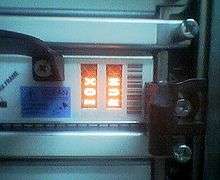Cisco IOS XR
IOS XR is a train of Cisco Systems' widely deployed Internetworking Operating System (IOS), used on their high-end Network Converging System (NCS), carrier-grade routers such as the CRS series, 12000 series, and ASR9000 series.

Architecture
According to Cisco's product literature, IOS XR shares very little infrastructure with the other IOS trains, and is instead built upon a "preemptive, memory protected, multitasking, microkernel-based operating system".[1] The microkernel was formerly provided by QNX[2]; versions 6.0 onwards use the Wind River Linux distribution.[3]
IOS XR aims to provide the following advantages over the earlier IOS trains:
- Improved high availability (largely through support for hardware redundancy and fault containment methods such as protected memory spaces for individual processes and process restartability)
- Better scalability for large hardware configurations (through a distributed software infrastructure and a two-stage forwarding architecture)
- A package based software distribution model (allowing optional features such as multicast routing and MPLS to be installed and removed while the router is in service)
- The ability to install package upgrades and patches (potentially while the router remains in service)
- A web-based GUI for system management (making use of a generic, XML management interface)
History
IOS XR was announced along with the CRS-1 in May 2004.[4] The first generally available version was 2.0. The most recent release is version 6.5.3[5] which was released in March 2019.
Other significant releases include the following.
- 3.2 – first generally available version for the 12000 router series
- 3.9 – first generally available version for the ASR9000 series
- 5.0 (September 20, 2013) – first generally available version for the NCS6000 series, which is based upon a Linux kernel[6]
- 6.1.1 - Introduces support for the 64-bit Linux-based IOS XR operating system on ASR9000 series [7]
Differences between IOS and IOS XR
Example BGP configuration for both IOS and IOS XR. More examples can be found in the Cisco document Converting Cisco IOS Configurations to Cisco IOS XR Configurations.[8]
! Cisco IOS
!
router bgp 109
no synchronization
bgp log-neighbor-changes
neighbor 203.0.113.1 remote-as 109
neighbor 203.0.113.1 update-source Loopback0
no auto-summary
!
! Cisco IOS XR
!
router bgp 109
neighbor 203.0.113.1
remote-as 109
update-source Loopback0
!
!
References
- "Products & Services". Cisco.
- QNX press release confirming use of their microkernel in IOS XR
- "Cisco IOS XR Software Release 6.0 Operational Enhancements Data Sheet". Cisco.
- "Cisco press release announcing CRS-1 and IOS XR". Archived from the original on March 9, 2005.
- Cisco's release notes, for the various IOS XR versions
- "Release Notes for Cisco NCS 6000 Series Routers, Release 5.0.0". Cisco.
- http://www.cisco.com/c/en/us/td/docs/routers/asr9000/software/asr9k_r6-1/general/release/notes/b-release-note-asr9k-612.html
- "Converting Cisco IOS Configurations to Cisco IOS XR Configurations" (PDF). cisco.com. Cisco Systems. Retrieved August 4, 2017.
External links
- Cisco multimedia documentation covering IOS XR and its supported systems
- Cisco Security Advisories - complete history
- Cisco IOS XR Software General Information
- Cisco CRS Support Page
- Cisco XR 12000 Series Router Support
- Cisco ASR 9000 Series Support
- HEAnet's New Network and Working with IOS-XR